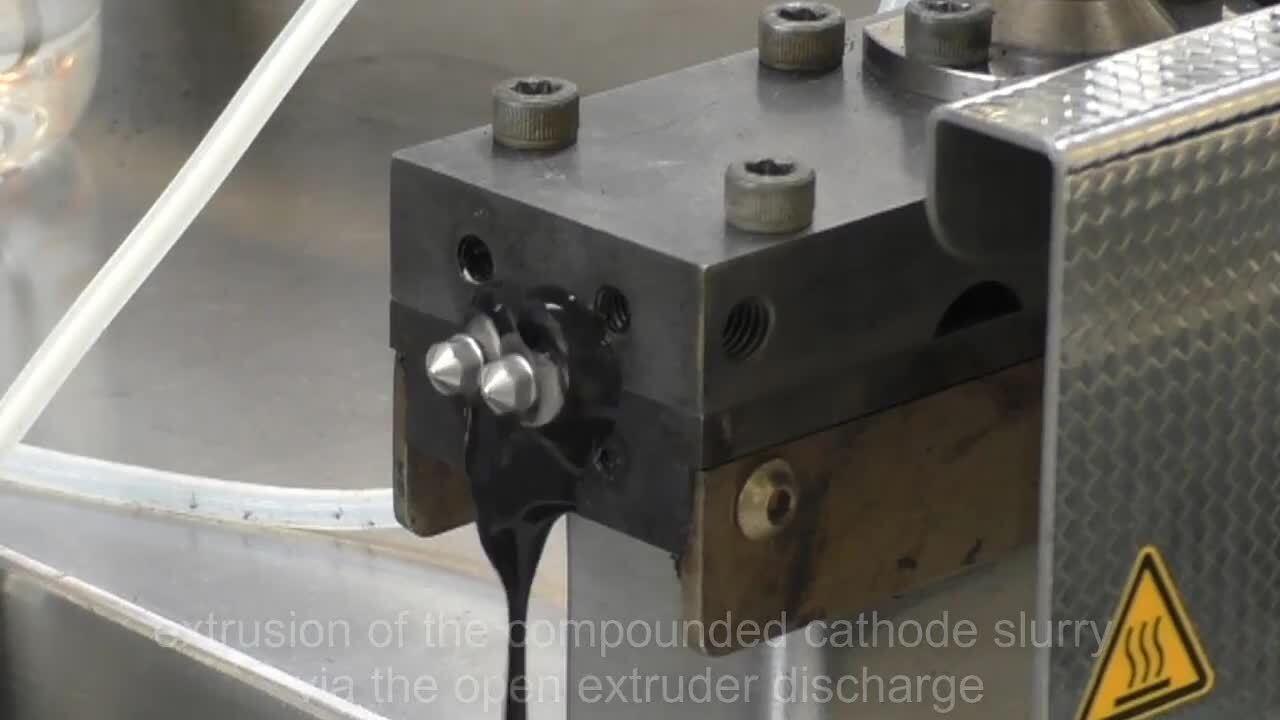In our everyday life, we need energy to cover our increasing demand for communication and mobility. At the same time, this energy needs to be produced and stored in sustainable ways to save the precious resources of our ecosystem.
Lithium-ion batteries (LIBs) are widely used in portable electronics, electric vehicles, and grid storage due to their high energy density and long cycle life. Many innovative materials have been adopted and commercialized to increase battery performance.
Battery process technology, on the other hand, bears great potential for improvement to realize the full potential of available chemistry. Twin-screw extrusion can help optimize the manufacturing processes of batteries to make them safer, more powerful, longer lasting, and more cost-effective. Rheological characterization of battery slurries is necessary to ensure an efficient screen-printing process and to develop new formulations.
Lithium-ion battery slurry
During the multi-step process from raw materials to the final battery cell, the use of a twin-screw extruder can improve the critical step of electrode material production (aka battery slurries).
Battery slurry production is commonly realized by batchwise mixing of active materials, carbon black, solvents, binders, and additives in stirred vessels. This process is labor-intensive, bears the risk of batch-to-batch variations, and requires production downtimes for cleaning.
Twin-screw compounding offers a continuous production process with precisely controlled material shear, heat transfer, material throughput, and residence time. The twin-screw extrusion process provides high reproducibility, less cleaning time, and high material and labor efficiency.
The excellent dispersive and distributive mixing capabilities of a twin-screw extruder enable much more homogeneous cathode pastes as compared to alternative batch mixing in, for example, a dissolver. In return, this can lead to improved material properties.
Cathode slurry mixed using a dissolver
Cathode slurry mixed using an extruder
© Pictures are courtesy of University of Braunschweig, IPAT, Mr. Mattis Batzer
Battery manufacturing applications
Learn more about applications in which twin-screw extrusion can help improve the classic production of cathode and anode slurries by moving from a batch that is challenging to scale up to a well-controlled continuous process. A reduction of solvent from the process can save up to 30% of the total energy consumption; here, extruders can help produce almost-dry battery pastes. Ways to overcome the risk of shorting and fire caused by flammable organic electrolyte novel battery types are being investigated. Extruders provide excellent capabilities for solid state battery (SSB) development. An understanding of the rheological properties of an electrode slurry is necessary for a precise printing process to obtain batteries with a high capacity and a high number of charging cycles.
Continuous production of battery slurries
Cathode and anode slurry compounding
Solvent-free cathode and anode slurries
Solid-state lithium batteries
Learn more by reading the following publications:
Rheology for lithium-ion battery manufacturing
Battery manufacturing instruments from Thermo Fisher Scientific
During process development, versatility and easy handling are paramount. Moisture-sensitive materials, together with solvent vapors hazardous to health, often require electrode production to be carried out under inert atmosphere. Therefore, it is important to be able to operate all instrumentation in a containment area, such as a glove box, without compromising the equipment’s full benefits.
We provide lab- and pilot-scale extrusion equipment that is used globally by numerous academic and industrial market leaders in the area of battery development. Our solutions offer:
- Small footprint — The Thermo Scientific Energy 11 Twin-Screw Compounder represents all functionalities of a production extruder scaled down to a lab-sized unit to fit into confined spaces in safety workbenches and glove boxes.
- Robustness — All electronics are fitted into the compact unit and show best performance when operated under inert atmosphere.
- Split and removable barrel design — Easy to open and close, even within tight spaces. Thorough cleaning with no dead spaces. Easy exchange of all contact parts to prevent cross-contamination when performing different application on the same instrument.
- Segmented screw design — Easy customization of mixing behavior for specific application needs.
- Versatility — Wide range of accessories to accommodate a wide variety of applications: granulation setup, film die and take-off, face-cut pelletizer for dry slurries, different die designs for slurry process.
Extruders
Rheometers
Resources
Application notes
Posters
Scientific publications
For Research Use Only. Not for use in diagnostic procedures.

